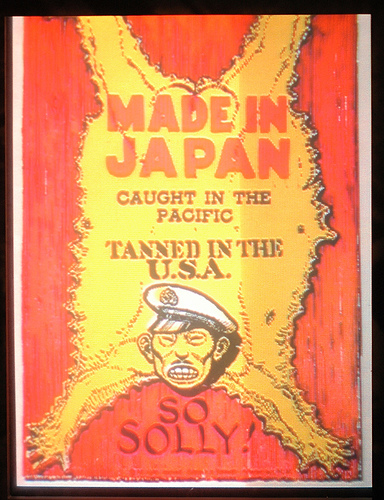All that changed in one day. Japan planned to take new territory in southeastern Asia in order to gain oil resources, but they feared the intervention of the U.S. Pacific Fleet. On December 7, 1941, Japan launched a surprise air attack on the naval base at Pearl Harbor in Hawaii. Over the course of the next two hours, 2,402 Americans were killed, a thousand more were wounded, and all eight battleships in the U.S. Pacific Fleet were either sunk or badly damaged. All of the aircraft carriers, however, survived.
President Franklin D. Roosevelt described the day of Pearl Harbor as "a date which will live in infamy," and he was right. The concept of continued isolationism disappeared almost overnight as America was swept up in a wave of patriotism. On December 8, the very next day, the United States declared war on Japan, finally entering World War II on the side of the Allies. Germany and Italy, Japan's allies, declared war on the United States soon afterward, which the U.S. quickly reciprocated.
America's reaction to Pearl Harbor was, to make a modern comparison, similar in many ways to the aftermath of 9/11. The American people were filled with a sense of patriotism, and young men began enlisting in droves. The film Sergeant York, a biography of a soldier in World War I, became the best-selling film of 1941 thanks to this newfound sense of patriotism. America's entry into the war also served to resurrect the economy, helping to finish bringing the country out of the Great Depression.
Not all of the effects of Pearl Harbor were so positive, however. The attack on Pearl Harbor was one of the few times throughout history that America was attacked on its own soil, and it came as a complete surprise to most of the American people. One other emotion vied with patriotism for prominence: fear. As Kennett puts it, "Overnight the idea of bombs falling on American cities grew from a remote possibility to a real and immediate danger" (26). Americans, quite simply, no longer felt safe.
This fear, unfortunately, quickly turned into xenophobia, most of it directed towards the Japanese. Events such as the Niihau Incident, where Japanese-American locals on the Hawaiian island of Niihau helped defend a Japanese pilot whose plane had been damaged in the attack on Pearl Harbor, only served to further spread this fear. It was felt that anyone of Japanese ancestry, including American citizens, couldn't be trusted; they might try to sabotage the war effort. Racist stereotypes of the Japanese were common in the media of the time, even in such unexpected places as Bugs Bunny cartoons:
All the anti-Japanese sentiment in America found its most horrifying outlet, of course, in the Japanese internment camps. On February 19, 1942, Executive Order 9066 forced all Japanese-Americans on the Pacific coast to move into internment camps. It is telling that internment camps were set up only for the Japanese. America was at war with Germany and Italy as well, yet those of German and Italian ancestry were not forced to leave their homes.
Many authors, filmmakers, and the like considered it part of their mission to teach hatred of America's enemies, both the Japanese and the Nazis. There is no doubt that much of the literary and artistic efforts of the time were directly affected by the attack on Pearl Harbor and America's entry into the war. While many criticized writers and artists for not taking up weapons and joining in the battles themselves, most artists felt they had an important role to play in raising morale, although opinions differed on exactly how they should go about doing so. Some felt that it was their job to offer simple entertainment, in order to help keep people's minds off the stresses of wartime. Others thought the war effort would be better served by realistic portrayals of the war, to help combat the inevitable feelings of distance that occurred when a war was being fought thousands of miles away from home.
War-related books certainly did sell particularly well during 1942, directly after the attack on Pearl Harbor. For once, non-fiction actually began to outsell fiction. Books such as W. F. Kernan's Defense Will Not Win the War, Alexander Seversky's Victory Through Air Power, and Marion Hargrove's See Here, Private Hargrove sold exceptionally well during early 1942. Even popular novels of the time, such as John Steinbeck's The Moon is Down and Pearl Buck's Dragon Seed, were related to the war.
Even in later years, Pearl Harbor and its aftermath would continue to resonate in American memory. In decades afterward, many Asian-American authors would come to write about their experiences in internment camps. Novels such as John Okada's No-No Boy (1957) and Monica Sone's Nisei Daughter (1953) provide examples of the difficulties faced by Japanese-Americans in the wake of the xenophobia stirred up by Pearl Harbor. Even as recently as 2001, the film Pearl Harbor proved to be a huge financial success, showing just how lasting an effect the events of December 7 had on the American people as a whole.
Sources
- http://www.pearlharbor.org/history-of-pearl-harbor.asp
- http://www.history.com/topics/pearl-harbor
- Kennett, Lee. For the Duration: The United States Goes to War. New York: Charles Scribner's Sons, 1985. Print.
- Images from: https://www.google.com/search?q=anti-japanese+propaganda&hl=en&qscrl=1&prmd=imvns&tbm=isch&tbo=u&source=univ&sa=X&ei=xeZOT56TGsOhtweilpnGDQ&ved=0CCwQsAQ&biw=1280&bih=937
- Video from: http://www.youtube.com/

No comments:
Post a Comment